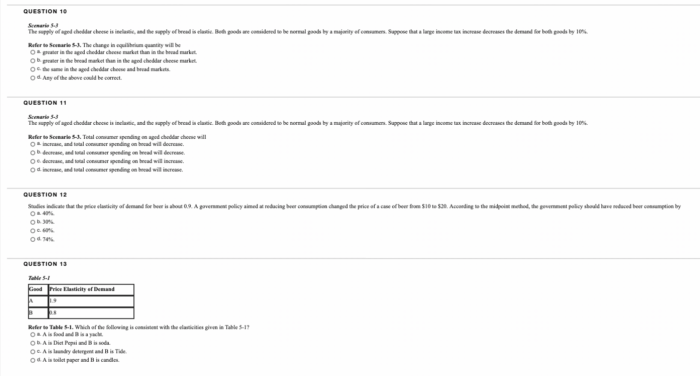The supply of aged cheddar cheese is inelastic, a fascinating economic phenomenon that significantly impacts its price and availability. This article delves into the intricacies of inelastic supply, exploring its causes, consequences, and potential solutions for both producers and consumers.
Inelastic supply arises when a change in price has a minimal effect on the quantity supplied. In the case of aged cheddar cheese, factors such as production time, aging requirements, and limited production capacity contribute to its inelastic supply.
Understanding Inelastic Supply

Inelastic supply refers to a situation where the quantity supplied of a good or service changes relatively little in response to price fluctuations. In other words, producers are not highly responsive to price signals, and supply remains relatively constant regardless of changes in demand.
Examples of products with inelastic supply include:
- Essential goods (e.g., food, water, shelter)
- Luxury goods (e.g., diamonds, fine art)
- Goods with high production costs (e.g., specialized machinery)
Factors Affecting Inelasticity
Several factors contribute to inelastic supply:
- Time constraints:Production processes may be lengthy or complex, limiting the ability to increase output quickly.
- Limited resources:Scarce raw materials or specialized skills may restrict supply expansion.
- Fixed costs:High fixed costs (e.g., equipment, infrastructure) make it costly to adjust production levels.
- Government regulations:Licensing, quotas, or other regulations can limit the entry of new producers.
Implications for Aged Cheddar Cheese, The supply of aged cheddar cheese is inelastic
The supply of aged cheddar cheese is highly inelastic due to the lengthy aging process and the specialized skills required. This inelasticity has significant implications:
- Price fluctuations:Small changes in demand can lead to large price fluctuations.
- Limited availability:Supply shortages can occur when demand exceeds production capacity.
- Seasonality:Production cycles can create seasonal variations in supply and price.
Market Strategies for Inelastic Supply
Cheese producers employ various strategies to manage inelastic supply:
- Inventory management:Maintaining sufficient inventory to buffer against demand fluctuations.
- Pricing strategies:Adjusting prices to balance supply and demand, or using contracts to secure long-term sales.
- Product diversification:Offering a range of cheese products to mitigate the impact of inelasticity on specific varieties.
Government Intervention
Governments may intervene in markets with inelastic supply to ensure consumer access and stability:
- Subsidies:Providing financial support to producers to increase supply.
- Price controls:Setting maximum or minimum prices to prevent excessive price fluctuations.
- Market regulations:Establishing rules to promote competition and prevent market manipulation.
Consumer Impact
Inelastic supply can impact consumers:
- Price sensitivity:Consumers may be vulnerable to price increases due to limited supply options.
- Availability:Shortages can make it difficult to obtain desired products.
- Substitution:Consumers may switch to alternative products with more elastic supply.
Answers to Common Questions: The Supply Of Aged Cheddar Cheese Is Inelastic
What factors contribute to the inelastic supply of aged cheddar cheese?
Production time, aging requirements, and limited production capacity.
How does inelastic supply affect the price of aged cheddar cheese?
It makes the price less responsive to changes in demand, leading to higher prices during periods of high demand.
What strategies can producers use to manage inelastic supply?
Diversify product offerings, implement production efficiency measures, and engage in long-term contracts with suppliers.

